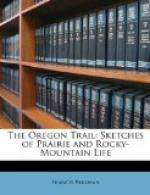Reaching the bank of the river, we followed it for some distance farther, until we discerned through the twilight the white covering of our little cart on the opposite bank. When we reached it we found a considerable number of Indians there before us. Four or five of them were seated in a row upon the ground, looking like so many half-starved vultures. Tete Rouge, in his uniform, was holding a close colloquy with another by the side of the cart. His gesticulations, his attempts at sign-making, and the contortions of his countenance, were most ludicrous; and finding all these of no avail, he tried to make the Indian understand him by repeating English words very loudly and distinctly again and again. The Indian sat with his eye fixed steadily upon him, and in spite of the rigid immobility of his features, it was clear at a glance that he perfectly understood his military companion’s character and thoroughly despised him. The exhibition was more amusing than politic, and Tete Rouge was directed to finish what he had to say as soon as possible. Thus rebuked, he crept under the cart and sat down there; Henry Chatillon stopped to look at him in his retirement, and remarked in his quiet manner that an Indian would kill ten such men and laugh all the time.
One by one our visitors rose and stalked away. As the darkness thickened we were saluted by dismal sounds. The wolves are incredibly numerous in this part of the country, and the offal around the Arapahoe camp had drawn such multitudes of them together that several hundred were howling in concert in our immediate neighborhood. There was an island in the river, or rather an oasis in the midst of the sands at about the distance of a gunshot, and here they seemed gathered in the greatest numbers. A horrible discord of low mournful wailings, mingled with ferocious howls, arose from it incessantly for several hours after sunset. We could distinctly see the wolves running about the prairie within a few rods of our fire, or bounding over the sand-beds of the river and splashing through the water. There was not the slightest danger to be feared from them, for they are the greatest cowards on the prairie.




